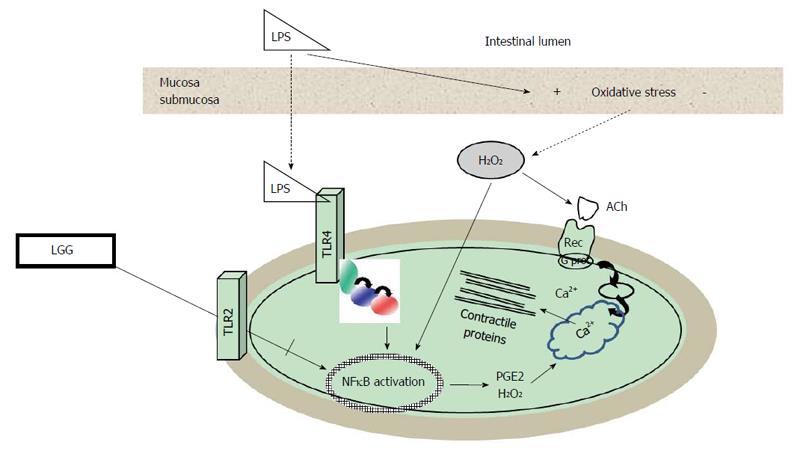Copyright
©The Author(s) 2016.
World J Gastroenterol. Dec 7, 2016; 22(45): 9871-9879
Published online Dec 7, 2016. doi: 10.3748/wjg.v22.i45.9871
Published online Dec 7, 2016. doi: 10.3748/wjg.v22.i45.9871
Figure 1 Dysbiosis and intestinal motility disorders.
One hypothesis regarding the pathogenesis of functional intestinal disorders suggests that dysbiosis increases paracellular permeability leading to translocation of luminal contents with activation of immunocytes, cytokines and inflammatory mediators release. The activation of this state of inflammation and the presence of bacterial components, such as LPS, lead to nociceptive hypersensitivity, thus explaining the pain, and to enteric nervous system (ENS) or muscle impairment, thus explaining the intestinal motor disorders. LPS: Lipopolysaccharide.
Figure 2 Role of toll-like receptors on human colonic smooth muscle cells.
LPS affects intestinal contractility by activating oxidative stress in the mucosa and, once translocated, by activating TLR4 expressed in colonic muscle cells. Activation of muscular TLR4 impairs cell contractility by activation of the nuclear factor kB transcription with intracellular increase of oxidative stress and by prostaglandin E2 (PGE2) that block intracellular calcium release. The oxygen free radicals, produced in the mucosa, impair cell contractility with a similar mechanism and also by de-regulation of contractile receptors. The activation of TLR2, whose ligands are the components of the outer membrane of Gram-positive bacteria, such Lactobacillus rhamnosus GG (LGG), prevents LPS-induced muscular alterations. TLR4: Toll-like receptor 4; LPS: Lipopolysaccharide.
- Citation: Guarino MPL, Cicala M, Putignani L, Severi C. Gastrointestinal neuromuscular apparatus: An underestimated target of gut microbiota. World J Gastroenterol 2016; 22(45): 9871-9879
- URL: https://www.wjgnet.com/1007-9327/full/v22/i45/9871.htm
- DOI: https://dx.doi.org/10.3748/wjg.v22.i45.9871










